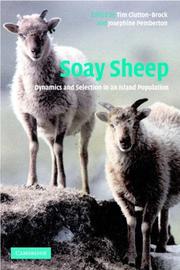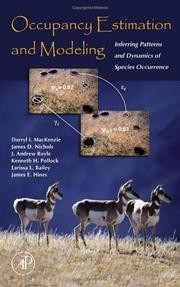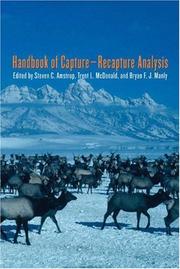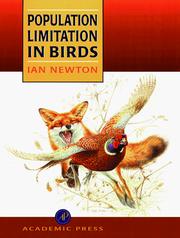| Listing 1 - 10 of 814 | << page >> |
Sort by
|
Book
Year: 2022 Publisher: London : IntechOpen,
Abstract | Keywords | Export | Availability | Bookmark
 Loading...
Loading...Choose an application
- Reference Manager
- EndNote
- RefWorks (Direct export to RefWorks)
Insects are a group of animals that contribute significantly to the proper functioning of different ecosystems on the planet. They provide services such as pollinating crops, recycling nutrients and controlling pests. Many scientific publications and reports have studied the current global decline of insects. This decline can severely affect other groups of animals including birds, reptiles, amphibians, fish, and small mammals that utilize insects as a source of food. This will have a great impact on the trophic cascade and an eventual adverse effect on the overall ecosystem. This book provides insights into the possible reasons behind the decline of insects as well as potential measures that might mitigate this decline. It contains eleven chapters written by different experts. The book is useful for a wide range of readers including entomologists, ecologists, botanists, environmentalists, and amateurs who love collecting and preserving insects.
Book
ISBN: 1774078503 9781774078501 Year: 2020 Publisher: Ashland Delve Publishing
Abstract | Keywords | Export | Availability | Bookmark
 Loading...
Loading...Choose an application
- Reference Manager
- EndNote
- RefWorks (Direct export to RefWorks)

ISBN: 9780511550669 9780521823005 9780521529907 9781107321618 1107321611 0521823005 0521529905 0511550669 1107146097 113980992X 1107317185 1107316227 1107318033 1299399339 1107315247 Year: 2004 Publisher: Cambridge Cambridge University Press
Abstract | Keywords | Export | Availability | Bookmark
 Loading...
Loading...Choose an application
- Reference Manager
- EndNote
- RefWorks (Direct export to RefWorks)
Soay Sheep synthesises one of the most detailed studies of demography and dynamics in a naturally regulated population of mammals. Unlike most other large mammals, the Soay sheep population of Hirta in the St Kilda archipelago show persistent oscillations, sometimes increasing or declining by more than 60% in a year. Soay Sheep explores the causes of these oscillations and their consequences for selection on genetic and phenotypic variation within the population, drawing on studies over nearly twenty years of the life-histories and reproductive careers of many individuals. Covering population dynamics, demography and their effects on selection, energetic and resource limitations on the interaction between sheep and parasites, and the adaptive significance of their reproductive characteristics, it provides unique insights into the regulation of other herbivore populations and the effects of environmental change on selection and adaptation. It will be essential reading for vertebrate ecologists, demographers, evolutionary biologists and behavioural ecologists.
Soay sheep --- Mammal populations --- Sheep breeds --- Vertebrate populations --- Selection --- Ecology
Book
ISBN: 1610914732 9781610914734 Year: 1996 Publisher: Washington, D.C.
Abstract | Keywords | Export | Availability | Bookmark
 Loading...
Loading...Choose an application
- Reference Manager
- EndNote
- RefWorks (Direct export to RefWorks)
Mammal populations --- Bird populations --- Wildlife conservation --- Wildlife management --- Zoology --- Health & Biological Sciences --- Vertebrates --- Vertebrate populations --- Congresses

ISBN: 1280628499 9786610628490 0080455042 9780080455044 9781280628498 0120887665 9780120887668 Year: 2006 Publisher: Amsterdam Boston Elsevier/Academic Press
Abstract | Keywords | Export | Availability | Bookmark
 Loading...
Loading...Choose an application
- Reference Manager
- EndNote
- RefWorks (Direct export to RefWorks)
Occupancy Estimation and Modeling is the first book to examine the latest methods in analyzing presence/absence data surveys. Using four classes of models (single-species, single-season; single-species, multiple season; multiple-species, single-season; and multiple-species, multiple-season), the authors discuss the practical sampling situation, present a likelihood-based model enabling direct estimation of the occupancy-related parameters while allowing for imperfect detectability, and make recommendations for designing studies using these models.* Provides authoritative insigh
Animal populations --- Demography, Wildlife --- Populations, Animal --- Wildlife demography --- Wildlife populations --- Animal ecology --- Population biology --- Estimates of animal populations --- Zoology --- Animals --- Estimates. --- Mathematical models. --- Technique --- Counting --- Estimates --- Mathematical models --- Animal populations - Estimates --- Animal populations - Mathematical models


ISBN: 1282964836 9786612964831 1400837715 9781400837717 0691089671 069108968X 9780691089676 9780691089683 Year: 2010 Publisher: Princeton, NJ
Abstract | Keywords | Export | Availability | Bookmark
 Loading...
Loading...Choose an application
- Reference Manager
- EndNote
- RefWorks (Direct export to RefWorks)
Every day, biologists in parkas, raincoats, and rubber boots go into the field to capture and mark a variety of animal species. Back in the office, statisticians create analytical models for the field biologists' data. But many times, representatives of the two professions do not fully understand one another's roles. This book bridges this gap by helping biologists understand state-of-the-art statistical methods for analyzing capture-recapture data. In so doing, statisticians will also become more familiar with the design of field studies and with the real-life issues facing biologists. Reliable outcomes of capture-recapture studies are vital to answering key ecological questions. Is the population increasing or decreasing? Do more or fewer animals have a particular characteristic? In answering these questions, biologists cannot hope to capture and mark entire populations. And frequently, the populations change unpredictably during a study. Thus, increasingly sophisticated models have been employed to convert data into answers to ecological questions. This book, by experts in capture-recapture analysis, introduces the most up-to-date methods for data analysis while explaining the theory behind those methods. Thorough, concise, and portable, it will be immensely useful to biologists, biometricians, and statisticians, students in both fields, and anyone else engaged in the capture-recapture process.
Animal populations --- Demography, Wildlife --- Populations, Animal --- Wildlife demography --- Wildlife populations --- Animal ecology --- Population biology --- Mathematical models. --- Mathematical models --- Animal populations - Mathematical models --- Acqui 2006
Book
Year: 2020 Publisher: Frontiers Media SA
Abstract | Keywords | Export | Availability | Bookmark
 Loading...
Loading...Choose an application
- Reference Manager
- EndNote
- RefWorks (Direct export to RefWorks)
This eBook is a collection of articles from a Frontiers Research Topic. Frontiers Research Topics are very popular trademarks of the Frontiers Journals Series: they are collections of at least ten articles, all centered on a particular subject. With their unique mix of varied contributions from Original Research to Review Articles, Frontiers Research Topics unify the most influential researchers, the latest key findings and historical advances in a hot research area! Find out more on how to host your own Frontiers Research Topic or contribute to one as an author by contacting the Frontiers Editorial Office: frontiersin.org/about/contact
Genetics --- Disease --- Population Genetics --- Indigenous populations --- GWAS
Book
ISBN: 1501719629 9781501719622 9781501719639 1501719637 9781501719615 1501719610 9781501719615 Year: 2018 Publisher: Ithaca, NY
Abstract | Keywords | Export | Availability | Bookmark
 Loading...
Loading...Choose an application
- Reference Manager
- EndNote
- RefWorks (Direct export to RefWorks)
Urban Ornithology is the first quantitative historical analysis of any New York City natural area's birdlife and spans the century and a half from 1872 to 2016. Only Manhattan's Central and Brooklyn's Prospect Parks have preliminary species lists, not revised since 1967, and the last book examining the birdlife of the entire New York City area is now more than fifty years old.This book updates the avifaunas of those two parks, the Bronx, and other New York City boroughs. It treats the 301 bird species known to have occurred within its study area-Van Cortlandt Park and the adjacent Northwest Bronx-plus 70 potential additions. Its 123 breeding species are tracked from 1872 and supplemented by quantitative breeding bird censuses from 1937 to 2015. Gains and losses of breeding species are discussed in light of an expanding New York City inexorably extinguishing unique habitats.
Bird populations --- Birds --- Vertebrate populations --- Aves --- Avian fauna --- Avifauna --- Wild birds --- Amniotes --- Vertebrates --- Ornithology --- History.

ISBN: 0125173660 9781281514547 1281514543 9780080879239 0080879233 9780125173650 0125173652 9780125173667 9786611514549 Year: 1998 Publisher: San Diego
Abstract | Keywords | Export | Availability | Bookmark
 Loading...
Loading...Choose an application
- Reference Manager
- EndNote
- RefWorks (Direct export to RefWorks)
This book meets the demand for a comprehensive introduction to understanding the processes of population limitation. Recognized world-wide as a respected biologist and communicator, Dr. Ian Newton has now written a clear and detailed treatise on local scale population limiting factors in birds. It is based almost entirely on results from field studies, though it is set in a contemporary theoretical framework. The 16 chapters fall under three major section headings: Behavior and Density Regulation; Natural Limiting Factors; and Human Impacts. Population Limitation in Birds serves as a ne
Animal ethology and ecology. Sociobiology --- Birds --- Zoology --- Vertebrates --- Health & Biological Sciences --- Bird populations. --- Vertebrate populations --- Ecology.
Book
ISBN: 3428070364 3428470362 Year: 1990 Publisher: Berlin : Duncker & Humblot,
Abstract | Keywords | Export | Availability | Bookmark
 Loading...
Loading...Choose an application
- Reference Manager
- EndNote
- RefWorks (Direct export to RefWorks)
Population. --- Human population --- Human populations --- Population growth --- Populations, Human --- Economics --- Human ecology --- Sociology --- Demography --- Malthusianism
| Listing 1 - 10 of 814 | << page >> |
Sort by
|

 Search
Search Feedback
Feedback About UniCat
About UniCat  Help
Help News
News